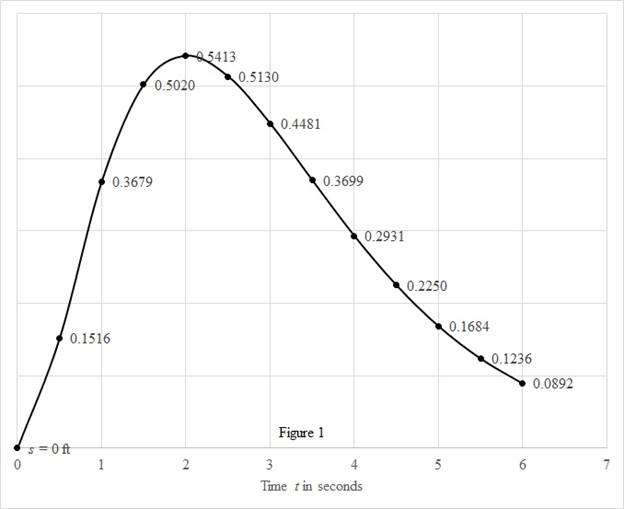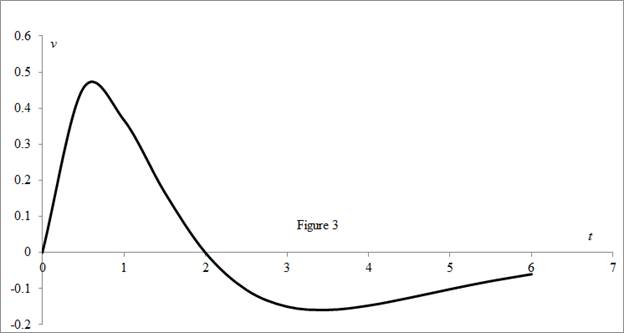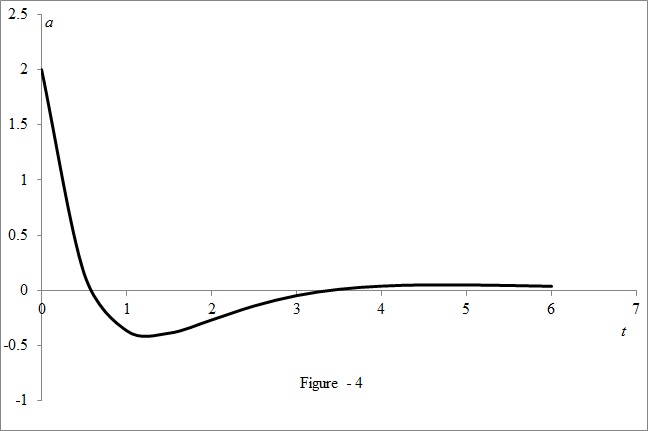
(a)
To find: The velocity at time t.
(a)
Answer to Problem 4E
The velocity at time is
Explanation of Solution
Given:
The given equation is as below.
Calculation:
Calculate the velocity at time
Differentiate the equation (1) with respect to time.
Therefore, the velocity at time
(b)
To find: The velocity after 1 second.
(b)
Answer to Problem 4E
The velocity after 1 second is
Explanation of Solution
Calculate the velocity after 1 second.
Substitute 1 for
Therefore, the velocity after 1 second is
(c)
To find: The time when particle at rest.
(c)
Answer to Problem 4E
The particle never is at rest when
Explanation of Solution
Calculate the time when particle will be at rest.
The velocity will be zero, when the particle is at rest.
Substitute 0 for
Therefore, the particle at rest when
(d)
To find: The particle moving in the positive direction.
(d)
Answer to Problem 4E
The particle will be moving in the positive direction within the time limits
Explanation of Solution
Calculate the time during which the particle will be moving in the positive direction.
If the particle moves in positive direction, the velocity at any time t will be greater than zero.
Therefore, the particle will be moving in the positive direction within the time limits
(e)
To find: The total distance traveled during the first 6 seconds.
(e)
Answer to Problem 4E
The total distance travelled during first 6 second is
Explanation of Solution
Calculate the total distance traveled during first 6 seconds.
Substitute 6 for
Therefore, the total distance travelled during first 6 seconds is
(f)
To find: The diagram to illustrate the motion of the particle.
(f)
Answer to Problem 4E
The diagram is shown in the figure (1).
Explanation of Solution
Show the diagram to illustrate the motion of the particle as shown below in figure (1).

(g)
To find: The acceleration at time t and after 1 second.
(g)
Answer to Problem 4E
The acceleration at time is
Explanation of Solution
Calculate the acceleration at time t.
Differentiate the equation (2) with respect to t.
Therefore, the acceleration at time is
Calculate the acceleration after 1 second.
Substitute 1 for
Therefore, the acceleration after 1 second is
(h)
To sketch: The graph the position, velocity, and acceleration function for
(h)
Answer to Problem 4E
The position, velocity, and acceleration functions are plotted for time limits
Explanation of Solution
Calculate the position using the formula.
Substitute 0 for
Similarly, calculate the remaining values.
Tabulate the value of
| 0 | 0 |
| 0.5 | 0.15163 |
| 1 | 0.36788 |
| 1.5 | 0.50204 |
| 2 | 0.54134 |
| 2.5 | 0.51303 |
| 3 | 0.44808 |
| 3.5 | 0.36992 |
| 4 | 0.29305 |
| 4.5 | 0.22496 |
| 5 | 0.16845 |
| 5.5 | 0.12362 |
| 6 | 0.08924 |
Calculate the velocity using the expression.
Substitute 0 for
Similarly, calculate the remaining values.
Tabulate the value of
| 0 | 0 |
| 0.5 | 0.4549 |
| 1 | 0.36788 |
| 1.5 | 0.16735 |
| 2 | 0 |
| 2.5 | -0.1026 |
| 3 | -0.1494 |
| 3.5 | -0.1585 |
| 4 | -0.1465 |
| 4.5 | -0.125 |
| 5 | -0.1011 |
| 5.5 | -0.0787 |
| 6 | -0.0595 |
Calculate the acceleration using the formula.
Substitute 0 for
Similarly, calculate the remaining values.
Tabulate the value of
| 0 | 2 |
| 0.5 | 0.15163 |
| 1 | -0.3679 |
| 1.5 | -0.3905 |
| 2 | -0.2707 |
| 2.5 | -0.1436 |
| 3 | -0.0498 |
| 3.5 | 0.00755 |
| 4 | 0.03663 |
| 4.5 | 0.04721 |
| 5 | 0.04717 |
| 5.5 | 0.04189 |
| 6 | 0.0347 |
Draw the position as a function of time curve as shown in the figure (2).

Draw the speed as a function of time curve as shown in the Figure (3).

Draw the acceleration as a function of time curve as shown in the Figure (4).

(i)
To find: The time when the particle is speeding up and slowing down.
(i)
Answer to Problem 4E
The acceleration is positive when the value of time
Explanation of Solution
Calculate the time when particle is speeding up and slowing down.
Substitute 0 for
Substitute
Substitute
Therefore, the acceleration is positive when the value of time
Chapter 3 Solutions
Single Variable Calculus: Concepts and Contexts, Enhanced Edition
- Can you help explain what I did based on partial fractions decomposition?arrow_forwardSuppose that a particle moves along a straight line with velocity v (t) = 62t, where 0 < t <3 (v(t) in meters per second, t in seconds). Find the displacement d (t) at time t and the displacement up to t = 3. d(t) ds = ["v (s) da = { The displacement up to t = 3 is d(3)- meters.arrow_forwardLet f (x) = x², a 3, and b = = 4. Answer exactly. a. Find the average value fave of f between a and b. fave b. Find a point c where f (c) = fave. Enter only one of the possible values for c. c=arrow_forward
- please do Q3arrow_forwardUse the properties of logarithms, given that In(2) = 0.6931 and In(3) = 1.0986, to approximate the logarithm. Use a calculator to confirm your approximations. (Round your answers to four decimal places.) (a) In(0.75) (b) In(24) (c) In(18) 1 (d) In ≈ 2 72arrow_forwardFind the indefinite integral. (Remember the constant of integration.) √tan(8x) tan(8x) sec²(8x) dxarrow_forward
- Find the indefinite integral by making a change of variables. (Remember the constant of integration.) √(x+4) 4)√6-x dxarrow_forwarda -> f(x) = f(x) = [x] show that whether f is continuous function or not(by using theorem) Muslim_mathsarrow_forwardUse Green's Theorem to evaluate F. dr, where F = (√+4y, 2x + √√) and C consists of the arc of the curve y = 4x - x² from (0,0) to (4,0) and the line segment from (4,0) to (0,0).arrow_forward
 Calculus: Early TranscendentalsCalculusISBN:9781285741550Author:James StewartPublisher:Cengage Learning
Calculus: Early TranscendentalsCalculusISBN:9781285741550Author:James StewartPublisher:Cengage Learning Thomas' Calculus (14th Edition)CalculusISBN:9780134438986Author:Joel R. Hass, Christopher E. Heil, Maurice D. WeirPublisher:PEARSON
Thomas' Calculus (14th Edition)CalculusISBN:9780134438986Author:Joel R. Hass, Christopher E. Heil, Maurice D. WeirPublisher:PEARSON Calculus: Early Transcendentals (3rd Edition)CalculusISBN:9780134763644Author:William L. Briggs, Lyle Cochran, Bernard Gillett, Eric SchulzPublisher:PEARSON
Calculus: Early Transcendentals (3rd Edition)CalculusISBN:9780134763644Author:William L. Briggs, Lyle Cochran, Bernard Gillett, Eric SchulzPublisher:PEARSON Calculus: Early TranscendentalsCalculusISBN:9781319050740Author:Jon Rogawski, Colin Adams, Robert FranzosaPublisher:W. H. Freeman
Calculus: Early TranscendentalsCalculusISBN:9781319050740Author:Jon Rogawski, Colin Adams, Robert FranzosaPublisher:W. H. Freeman
 Calculus: Early Transcendental FunctionsCalculusISBN:9781337552516Author:Ron Larson, Bruce H. EdwardsPublisher:Cengage Learning
Calculus: Early Transcendental FunctionsCalculusISBN:9781337552516Author:Ron Larson, Bruce H. EdwardsPublisher:Cengage Learning





